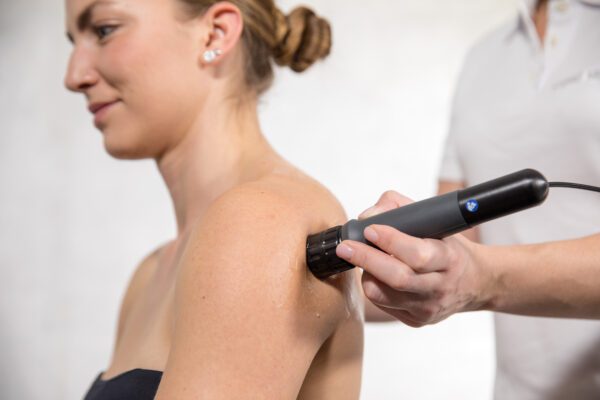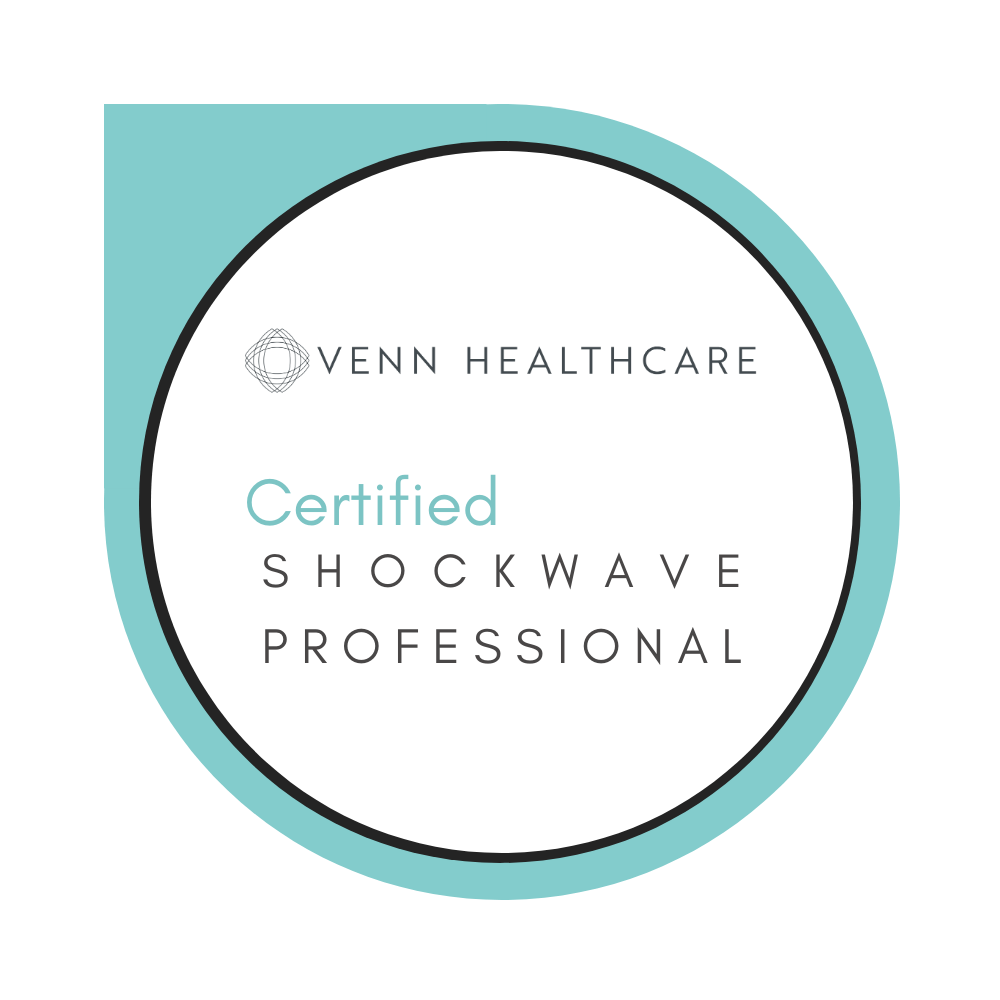
Shockwave Therapy
Shockwave therapy for soft tissue injury
What is shockwave therapy?
Shockwave therapy is an effective, safe and non-invasive treatment that uses a series of sound energy waves to promote the healing of injured soft tissue. These shockwaves are passed into the body by using various specialist applicators that are specifically designed for targeting different soft tissues.
When injury to soft tissue is proving challenging to treat it can be tempting to turn to surgery or steroid injections. But shockwave therapy can provide a gentle, safe and effective alternative.
The application of shock waves, or Extracorporeal Shockwave Therapy (ESWT) as it’s otherwise known, has been clinically proven to successfully treat plantar fasciitis and most tendon conditions including hamstring, patellar, achilles, gluteal and tennis elbow tendinopathies.
Shockwave treatment works by activating the healing process and stimulating pain-reducing enzymes. It targets the injured tissue with specially calibrated shockwaves that stimulate blood circulation and metabolism, accelerating the body’s own healing processes. The application of shockwaves gives pain relief after treatment and stimulates long-term tissue normalisation and regeneration.
What should I expect with shockwave therapy?
During the initial shockwave therapy consultation your practitioner will take a full clinical assessment of your condition to ensure shockwave therapy is the most appropriate intervention. If we feel this treatment is appropriate, we’ll discuss a course of treatment, typically weekly for three to six weeks. To complement this, your practitioner will design a series of rehabilitation exercises to maximise the effectiveness of the treatment.
To start, we’ll apply a contact gel to the skin over the area to be treated. The shockwave applicator will be applied to the area, whereby the shockwaves will begin to excite the injured tissue. This will stimulate your body to respond by increasing blood circulation in the soft tissues and triggering stem cell activation and enzyme production in the injured tissue. This, in turn, will promote and accelerate the healing process and reduce pain in the area. The process takes approximately 10 minutes.
The best results are achieved after six to twelve weeks from the final treatment with a continuing exercise programme alongside the shockwave therapy.
Is shockwave therapy painful?
Although it sounds like it would be, shockwave therapy is not painful but can be mildly uncomfortable. During the treatments the intensity of shockwave will be gently increased to allow the body to become accustomed to the sensation, thus reducing any pain felt. Sedation or anaesthetic are not necessary for shockwave therapy treatment.
With shockwave therapy treatment, many people experience immediate relief in their pain symptoms with increased movement in the affected area. However, the injured area must be rested for 24 hours before and after treatment, after which time the prescribed rehabilitation exercises can be resumed.








Why choose us for shockwave therapy?
At Thornbury Clinic we are trained and approved to provide shockwave therapy for treating all appropriate musculo-skeletal conditions.
The Thornbury Clinic uses the highest standard in shockwave therapy equipment in the UK – the Stors Masterpuls 200 radial shockwave machine. The MP200 shockwave machine is the highest specification of shockwave available and is used in private hospitals and elite sports institutions such as GB athletics. The machine is pre-calibrated to treat all the conditions but is adjustable to ensure maximum comfort during treatment whilst ensuring its utmost effectiveness.
No treatment is guaranteed 100% effective, but when you undertake steroid, injection therapy or surgery the costs can mount up, they incur potentially long waiting times, have some risks and potential side effects and are without guaranteed results. Shockwave therapy treatment at The Thornbury clinic is comparably very cost-effective.
At the Thornbury Clinic we can offer you shockwave therapy with or without a medical professional referral from your doctor or medical consultant. However, our experienced physiotherapists will still need to fully assess the extent of your injury before commencing a course of shockwave therapy treatment.
Our Team
 Nick RobilliardSenior PhysiotherapistRead More
Nick RobilliardSenior PhysiotherapistRead More Megan Miller-ZutshiLead Physiotherapist, Clinical DirectorRead More
Megan Miller-ZutshiLead Physiotherapist, Clinical DirectorRead More Jemma ChambersSenior PhysiotherapistRead More
Jemma ChambersSenior PhysiotherapistRead More

What is shockwave therapy suitable for?
Shockwave Therapy is one of few treatments that can work when an injury reaches a chronic non-healing state. There is evidence that shockwave treatment is successful in treating of plantar fascitis, achilles, hamstring, patellar, gluteal and tennis elbow tendinopathies.
Plantar Fasciitis – foot pain
Plantar fasciitis is the inflammation of the fibrous tissue of the sole, resulting in pain in the heel and over the bottom of the foot. This condition may be caused by over-use such as an increase in running and walking, standing for long periods, or after wearing shoes that do not support the foot arch or cushion the feet correctly. Shockwave therapy has been proven as an effective and non-invasive treatment for this painful condition.
Patellar Tendinopathy – knee pain
Patellar tendinopathy is an injury to the tendon that connects the kneecap (patella) to the shin bone. Also known as ‘jumper’s knee’, it causes pain in the front of the knee and is most common in, but not exclusive to, athletes whose sports activity involves frequent jumping. Shockwave therapy can successfully treat this condition by stimulating the body’s natural healing process, particularly when used in conjunction with rehabilitation exercises.
Achilles Tendinopathy – ankle pain
Achilles tendinopathy can be caused by repetitive activity and running or walking faster and on steeper ground. It can be experienced as pain and swelling of the tissue on the back of the heel and calf. Shockwave therapy and exercises to increase the loading tolerance of the achilles tendon can give excellent results in reduction of pain and return to normal activity.
Tennis or Golfers Elbow Tendinopathy – elbow pain
Tennis elbow can be caused by the repeated strain of gripping or twisting the hand or wrist. Symptoms are tenderness and pain on the outside of the elbow when gripping or lifting objects. Golfers elbow affects the tendons on the inside of the elbow. Shockwave therapy and rehabilitation exercises have proven to be effective in the treatment of symptoms for these conditions, stimulating blood flow, cell regeneration and healing, decreasing pain and restoring normal movement and function.
Gluteal Tendinopathy – hip pain
Gluteal tendinopathy often presents as severe pain in the side of the hip. The tendons are the fibres that connect the gluteal muscles to the hip bone. Shockwave therapy treatment together with rehabilitation exercises will help the tendon tolerate load with less pain and can result in normal pain-free activity.
Hamstring Tendinopathies – leg pain
Hamstring Tendinopathy is where the soft tissues that connect the muscles of the back of the thigh to the pelvis or lower legs become damaged. Shockwave therapy, in conjunction with a personalised programme of rehabilitation exercises, can help to resolve the symptoms.
Shoulder Tendinopathy – shoulder pain
Shoulder tendinopathy is damage to the shoulder tendons which can cause severe pain in the neck, arm or shoulder, restrict range of movement and make lifting or lying on the arm painful. Damage to the tendons can occur due to overloading, repetitive use or injury, or can be due to postural issues or poor movement patterns. Shockwave therapy and rehabilitation exercise is an effective, non-surgical and non-invasive treatment for this condition.
When is shockwave therapy not appropriate?
Shockwave therapy is effective for a variety of musculoskeletal conditions, which can be determined at your initial assessment with us. However, we advise against its use for the following:
- a circulation or nerve disorder;
- if there are signs of infection;
- on affected areas where there is a bone condition;
If you have any further questions, please feel free to contact us. Or simply click here to book an appointment. We are always here to help!




